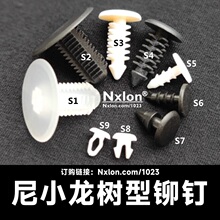Hexagonal Nut with Shoulder
©Nxlon.com D/T:

The hexagonal nut with shoulder is a kind of nut that adds a shoulder structure based on the ordinary hexagonal nut. The following is a detailed introduction to the hexagonal nut with shoulder:
Structural Features of the Hexagonal Nut with Shoulder
Hexagonal Head: Similar to ordinary hexagonal nuts, it has a hexagonal shape, which is convenient for using tools such as wrenches to tighten and loosen. It can provide a large force application surface, ensuring that the nut will not slip easily during the tightening process.
Shoulder Design: This is the main feature that distinguishes the hexagonal nut with shoulder from ordinary hexagonal nuts. The shoulder is located at one end of the nut, usually cylindrical, and its diameter is larger than the hexagonal part of the nut. The function of the shoulder is to increase the contact area between the nut and the connected part, improve the stability and reliability of the connection, and also play a certain positioning role to ensure the accurate position of the connected part during installation.
Specification Dimensions of the Hexagonal Nut with Shoulder
Thread Specifications: There are various thread specifications for the hexagonal nut with shoulder. Common ones include M4, M5, M6, M8, M10, M12, etc. Here, "M" represents the metric thread, and the following number represents the nominal diameter of the thread, with the unit being millimeters. Different application scenarios will select appropriate thread specifications according to the size of the bolt and the force-bearing requirements.
Nut Thickness: It includes the thickness of the hexagonal part and the height of the shoulder. Generally speaking, the total thickness of the nut is slightly thicker than that of an ordinary hexagonal nut to accommodate the shoulder design. For example, for an M8 hexagonal nut with shoulder, the thickness of the hexagonal part may be about 6 - 7 millimeters, the height of the shoulder is about 2 - 3 millimeters, and the total thickness is about 8 - 10 millimeters. The actual thickness will vary depending on the grade of the nut and specific standards.
Distance Across Flats: For hexagonal nuts with shoulder of the same specification as ordinary hexagonal nuts, the distance across flats is the same. For example, the distance across flats of an M6 hexagonal nut with shoulder is 10 millimeters, and that of an M10 hexagonal nut with shoulder is 16 millimeters.
Shoulder Dimensions: The diameter of the shoulder is usually about 2 - 5 millimeters larger than the nominal diameter of the nut's thread. For example, for an M8 hexagonal nut with shoulder, the diameter of the shoulder may be between 10 - 13 millimeters. The length (height) of the shoulder is generally between 1 - 5 millimeters, and the specific size depends on the specification of the nut and the usage requirements.
Application Fields of the Hexagonal Nut with Shoulder
Mechanical Manufacturing: In various mechanical equipment, it is used to connect and fasten components that require accurate positioning. For example, in the assembly of engines, it is used to fix some components that require precise installation positions, such as the valve cover and the oil pan. The shoulder can ensure that these components have an accurate relative position with other components during installation, avoiding failures caused by installation deviations.
Automotive Industry: In the manufacturing of automobiles, hexagonal nuts with shoulder are widely used in the connection of body structural parts and the assembly of key components such as engines and transmissions. For example, during the body welding process, it is used to fix some reinforcing plates and brackets. The shoulder can increase the stability of the connection and improve the strength and safety of the vehicle body.
Electronic Equipment: In the production of electronic equipment, it is used to fix some components with precise positioning requirements, such as circuit boards and displays. The shoulder can ensure that these components have an accurate relative position with other components during installation, avoiding poor electrical connections or a decrease in equipment performance caused by position deviations.
Furniture Manufacturing: In the assembly of furniture, it is used to connect some components that require accurate positioning, such as drawer rails and cabinet door hinges. The shoulder can ensure the accurate position of these components during installation, improving the usability and aesthetics of the furniture.
Materials and Surface Treatments of the Hexagonal Nut with Shoulder
Materials: It is usually made of medium carbon steel or medium carbon alloy steel, such as 45 steel, 40Cr, etc. These materials, after appropriate heat treatment, have high strength and hardness and can meet the fastening requirements of general mechanical connections. For some hexagonal nuts with shoulder used in special environments, stainless steel materials such as 304 stainless steel and 316 stainless steel will be used to improve the corrosion resistance and oxidation resistance of the nut; in some occasions with extremely high strength requirements, high-strength alloy steel materials will also be used.
Surface Treatments: Common surface treatments include galvanizing, nickel plating, blackening, etc. Galvanizing treatment can form a zinc protective film on the surface of the nut, effectively preventing the nut from rusting, and is suitable for most outdoor and general industrial environments; nickel plating treatment can not only improve corrosion resistance but also make the surface of the nut smoother and more beautiful, with good decorative properties, and is often used in occasions with high requirements for appearance and corrosion resistance; after blackening treatment, the nut has a certain rust prevention ability and a relatively simple appearance, and is often used for the internal connections of some machinery with low requirements for appearance but a certain rust prevention performance.
Installation and Disassembly of the Hexagonal Nut with Shoulder
Installation: Screw the hexagonal nut with shoulder onto the corresponding bolt and use a wrench to tighten the nut to the specified torque value. During the tightening process, ensure that the shoulder of the nut fits well with the surface of the connected part. The shoulder plays a positioning role to make the position of the connected part accurate. At the same time, pay attention to avoid the nut from tilting or being eccentric to avoid affecting the reliability of the connection.
Disassembly: Use a wrench to loosen the hexagonal nut with shoulder. If the nut is difficult to disassemble due to long-term use or rust, etc., you can first spray a rust remover on the threaded part and wait for a while before disassembling. During the disassembly process, pay attention to protecting the threads of the nut and the bolt to avoid damage, so as to facilitate subsequent reuse or replacement.
尼小龙塑料螺丝-塑料螺母-尼龙垫圈-塑料铆钉
塑料铆钉-尼小龙树形铆钉
订购链接:Nxlon.com/1023
绝缘塑料树形铆钉又称倒齿形塑料铆钉或圣诞树型塑料铆钉品名:树型塑料铆钉;材质:尼龙 Nylon;适合孔径:5.5mm-6.5mm;适合板厚:2.0mm-10.0mm
内4.2外7.0黑色塑料直通柱隔离柱
订购链接:Nxlon.com/1015
内4.2外7.0塑料直通柱隔离柱是一种用于电子设备等领域的绝缘零部件,尼小龙现有直通柱M4系列内径=4.2mm;外径:M4系列外径都是7mm;高度:2到15mm
绝缘尼龙十字沉头螺丝
订购链接:Nxlon.com/1017
绝缘尼龙十字沉头螺丝采用知名品牌进口注塑级尼龙PA66、参照国标GB819标准规定的尺寸制造而成。现货沉头塑料螺丝的螺纹规格有:M3*0.5mm、M4*0.7mm等。
塑料R型线夹圆形线卡拱形压线板
订购链接:Nxlon.com/1053
塑料R型线夹圆形线卡拱形压线板,材质:PP塑料、尼龙等。紧固孔:M4。塑料R型线夹圆形线卡拱形压线板,材质:PP塑料、尼龙等。紧固孔:M4。
绝缘塑料法兰螺母
订购链接:Nxlon.com/1034
尼龙法兰螺母的螺纹规格有:M3*0.5、M4*0.7、M5*0.8、M6*1.0、M8*1.25、M10*1.5、M12*1.75等白色尼龙螺母、黑色塑料螺母、透明塑料法兰螺母。
R3550-塑料铆钉-尼龙铆钉
订购链接:Nxlon.com/3550
R3550-塑料铆钉-尼龙铆钉塑料铆钉-尼龙铆钉-汽车塑胶铆钉-尼小龙尼龙铆钉R2.6R3.5R4R5塑胶柳钉子母铆钉快捷紧固件塑料卡扣。
尼小龙塑料SB通孔扣式护线套
订购链接:Nxlon.com/1051
绝缘塑料SB通孔扣式护线套16-19-22-25尼龙电缆电源线塑胶线孔盖质:尼龙,颜色:黑色、白色;规格:SB-16、SB-19、SB-22、SB-25等。









